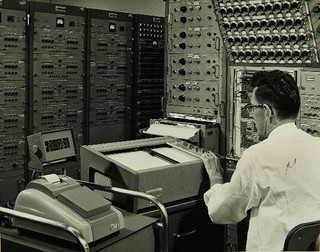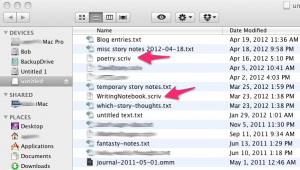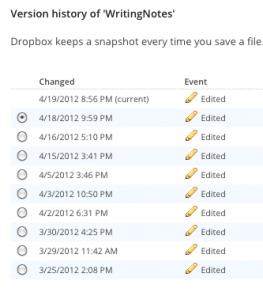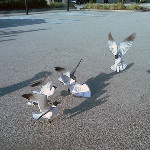R. Canepa's Blog
May 28, 2012
Monday, May 28th, 2012
I don’t usually blog the day-to-day kind of stuff, but thought I might shake things up and give it a go.
It’s been nice to finish my writing early today, to work past the difficult portion and sail into the calmer waters of Having A Clue Where The Scene Was Going, and being able to get it there with a minimal amount of fuss. I’ve split my time the past two weeks between producing work and reinvesting in my skills to better my work. It didn’t help that when I looked at the page, I promptly forgot everything I should do and could only remember what I shouldn’t do. The result of this was that I sat there staring at the screen. Not a very good way to write a story. So I stuffed that part of my brain into a box and just wrote. The nice thing about being done for the day is that I get to do other things guilt-free.
This video is amazing: Run Boy Run. It reminds me of both Where the Wild Things Are, which I’ve neither seen nor read–a crime, I know–and the game “Shadows of the Colossus,” simultaneously a beautiful game and one I can’t play without feeling terribly bad about playing it. Follow the link to see it bigger. It’s HD, after all.
Read a (digital) comic book today, one of a very few that I’ve read in my life (first issue of Eternals, for those curious). When it comes to comics, I mostly just read the text very quickly, and then feel bad that I almost didn’t even look at the art. So then I go back and look it over for a while, when I remember to do so, and I imagine that that’s not how one is supposed to read a comic. Does that mean I’m more of a text person than a visual person?
Right then. That’s all for now, so off I go.
Share this on Google+
Tweet This!
Share this on Tumblr
Share this on Facebook
Blog this on Blogger
Share this on del.icio.us
Digg this!
Stumble upon something good? Share it on StumbleUpon
May 24, 2012
Grasshopper Wing
1000-word flash fiction.
“Wait here a minute,” Dad said, “and don’t go near the water yet.” He then waded into the waist-high golden weeds that led away from the small, deep pool of water.
Kenny dropped the olive and tan tackle box he’d been tasked to carry, glad to put it down. The box required both hands to carry, held out in front of him on account of its large size, which set it to bumping his shins with every step on the hike down the hill to the stream behind their campsite.
When they didn’t know he was listening, Kenny’d heard his mom and dad arguing about the trip. She wanted to go to the beach. He wanted to camp in the woods and go fishing. “Kenny’s nine and has never been,” his dad had said. This was important. Somehow.
The stream was small and shallow, bordered by gray rocks the color of his schoolyard blacktop, capped here and there by crusty blue moss stuff Dad had said was “liken” (whatever that was). On the bottom was a brown muck the color of some disgusting family dinners.
He didn’t know why Dad had wandered off into the weeds—surely he’d have a whole ton of stickers now, the kind that pierce your sock and wedge themselves up against your shoe, poke you every time you take a step, and make you take off your shoes and dig them out one at a time.
Nearby was the fishing pole his father had brought: dark maroon segments that could collapse into one another, bright silver rings that guided thin, white-clear fishing line, and a black reel with a crank and a complicated-looking metal guide for the spool of line.
A thrashing sound announced the return of Dad, white t-shirt and blue jeans and the grass-stained sneakers he wore to mow the lawn, hands cupped together in front of him, face split in a triumphant grin.
Dad went straight to the rod while Kenny leaned over the deep pool for a closer look. Trees dropped orange leaves and dappled, golden light across the surface of the water. There, down below a rock that jutted out over the sandy bottom about a foot down, were two fish, plain as day.
Kenny looked over just in time to see Dad shove a grasshopper onto the end of a hook. It made a crunch sound. One of the wings tore off and fluttered to the ground like a leaf. Once, when the wing caught the light, Kenny saw rainbow colors instead of the clear.
“Oh,” Kenny said. He looked away from where the wing landed on the ground. The rainbow was gone.
“What’s that, son?”
“Nothing. I just thought we were going to use the eggs.” Before they’d left camp, Dad had opened the tackle box and shown him hooks, sinkers, spinners, and a jar of fake fish eggs: little red spheres that smelled nasty but apparently passed for fish snacks.
“Nah,” Dad said, and handled the pole across to Kenny. “This here’s the real deal. My dad did the same thing for me, my first time. It’s like a fish Big Mac. They can’t refuse.”
Kenny took the pole and tried not to look at what dangled from the end of it.
“Okay, now hook your pointer finger down around the line to hold it,” Dad said.
Kenny fumbled with the pole, then did so. “Like that?” He wanted to do this right.
“Now flip open the catch. Good. Now just give it a little toss, and let go with your finger.”
The grasshopper and hook landed on a rock on the other side of the pool.
“That’s okay,” Dad said. “Reel it in nice and slow.”
Kenny gave the reel a timid crank. The guide clunked into place, and the grasshopper slid into the pond, sending rings of ripples out across the calm surface of the pool, but didn’t sink. The fish just watched from their little spot under the rock.
“Maybe they don’t like grasshoppers?” Kenny suggested.
“Do it again,” Dad said.
Kenny cast the bait again, praying for a direct hit and a dramatic fish-fighting scene, so that they could call this a success and just go. Fishing’d sounded like fun, until they hiked out here, until Kenny got stickers in his socks even though he stayed in the clear areas behind his dad, until the bug went crunch on the hook and the sun beat down on them and made his back get all sweaty under his red Spiderman t-shirt.
The bug hit dead center of the pool this time.
Bullseye!
But no fish came up for a bite.
They stood for ten minutes in silence, watching the fish watch the grasshopper.
Dad was trying, Kenny knew. He was trying, too. Even though he decided he didn’t like fishing very much.
When they finally gave up, Kenny busied himself skipping rocks into the pool while Dad packed everything up. At first splash, the watching fish disappeared deeper under the rock.
Take that, stupid fish.
Another grasshopper jumped and landed on a nearby weed. Kenny paused, his rock-skipping arm half-drawn back, and squinted at its small, tan form. Its wings were clear, but sometimes had colors, too. On the ground, the other wing was dirty now, crushed into the sandy muck by Dad’s shoe.
With a rasping flutter, the grasshopper bounced off the weed.
Kenny nodded. Clear. But rainbow, too.
On the walk back to camp, he decided that the real color of a grasshopper wing was the happy freedom to bounce around in a field. The color of a grasshopper wing was also sadness when you got shoved onto the end of a hook, which was doubly dumb when the fish didn’t even bite, so you were better off not getting caught and baited in the first place.
If someone asked, would he say it was clear? Rainbow?
Both.
Share this on Google+
Tweet This!
Share this on Tumblr
Share this on Facebook
Blog this on Blogger
Share this on del.icio.us
Digg this!
Stumble upon something good? Share it on StumbleUpon
May 23, 2012
Wherein Cereal Makes Me A Better Writer

Image by kasiya
I just had a funny thought: “I really want a bowl of cereal. Surely some Lucky Charms will make me a better writer.”
Mostly, I think my brain is craving cereal. And yet.
When I was a kid, I held the unshakeable belief that a pair of new shoes made me run faster, jump higher, and altogether much cooler. As if, during the manufacturing process, they put some kind of mojo in between the layers of leather and rubber. Or perhaps some fairy godmother or wizard on loan from fantasy epics blessed each pair as they rolled by on the conveyor. Heck, I don’t even know that I had a reason why it was so. It just was. Unquestioned. Pure, iron-clad, unshakeable kid-logic truth. And when I laced those suckers up–or tightened up the velcro straps (yeah, I was that cool)–the world knew to watch out.
As we age, we lose the strength of our convictions, invariably replacing ours with those on loan from people who feel they know better than us. Since when is it unnecessary or uncool to believe in ourselves? Marketing, too, is driven by this idea: use their product, and we’ll be better/sexier/whatever. And, oftentimes, the marketing and products work. We feel better/sexier/whatever. But the magic isn’t in whatever doodad they’ve sold us: the magic is in belief. And so if we can separate belief from money, and remind ourselves that the latter does not beget or validate the former, then we can recapture some of that kid-logic. Putting on a lucky shirt, a flattering pair of pants, morning affirmations in front of the mirror, and other daily rituals tap into whatever shreds of our childhood remain.
If we believe something enough, does it become true?
When it comes to things like science and politics, absolutely not (despite what various organizations say).
But in the realm of the internal? For sure.
Internally, belief is a fuel to create all kinds of realities. It freezes ambiguous intentions into the solid form of truth and helps you figure out what the heck you want. In the landscape of the mind, if you believe it, writing enough stories will make you successful, that new haircut does make you look better, five minutes a day spent in reflection does make you a better person, cereal does make me a better writer, and new shoes do make the young version of myself run faster.
Share this on Google+
Tweet This!
Share this on Tumblr
Share this on Facebook
Blog this on Blogger
Share this on del.icio.us
Digg this!
Stumble upon something good? Share it on StumbleUpon
April 27, 2012
The Evolution of the Bit
 What would the reaction be like if we could go back in time to the 50s to tell computer researchers that, yes, not only do we have more powerful computers than anything they could imagine–and we carry them around in our pockets–but that we spend the majority of our usage talking to one another in little text chunks and playing games. Seeing as our phones are likely orders of magnitude more advanced than what folks in the 60s used to ship people to the moon, it only makes sense that the main usage for our iPhones and Androids is to hurl little aviary missiles at the digital equivalent of Lincoln Logs.
What would the reaction be like if we could go back in time to the 50s to tell computer researchers that, yes, not only do we have more powerful computers than anything they could imagine–and we carry them around in our pockets–but that we spend the majority of our usage talking to one another in little text chunks and playing games. Seeing as our phones are likely orders of magnitude more advanced than what folks in the 60s used to ship people to the moon, it only makes sense that the main usage for our iPhones and Androids is to hurl little aviary missiles at the digital equivalent of Lincoln Logs.
Would it blow their minds to learn of the vast server farms that we run or the coverage of 3g connectivity? Wireless Xbox controllers? Accelerometers in Wiimotes? The consumer-available motion capture technology in the Xbox Kinect? Could they even imagine the flood of cheap processing, memory and storage that made all of this possible? Would they understand how much we rely on it? Hell, I haven’t used a phone book in at least a decade. Imagine all this from the perspective of a time when computers were the size of a small house and processing the motion of a peripheral to update a mouse cursor on a display would have been too much computational overhead. A “waste of cycles.”
I had an electronics teacher who, in addition to working in the industry, also worked for a while at NASA, teaching radar to astronauts. One day, he told the class about a day in the lab where everyone gathered around a display and watched as one letter at a time blipped up on the screen in slow succession; someone was sending them a message from a remote location. It was the first time anyone in the room had ever seen anything like it.
Despite being raised on technology (my parents joke that I was born with a Nintendo controller in my hand), four areas of computation still amaze me:
Touch screens: Until we get implants and equal rights for cyborgs, there’s not much we can do to remove the barriers between computers and humans, but this was huge. Touching things is just human nature.
Speech recognition: This one goes both ways, text -> speech and speech -> text. Another barrier knocked over, one that makes computers more like us, and is only in its infancy. If I could go back in time, computational linguistics would be a fascinating career choice.
Drivers, hardware / software interaction: despite my years as a computer user and programmer, somehow it still twiddles my mind that on some fundamental level, these 1s and 0s interact with physical things.
Virtualization: The guys in 1950s lab coats were so proud of their room-sized computers. Imagine their faces when we tell them, “Oh yeah? Well, we have computers that run entirely inside of other computers,” like some kind of binary turducken.
Where do we go from here? Is there a limit to Moore’s Law? If we look at what has happened in the last fifty years, can we even predict what our digital lives will be like in another fifty? Or even another ten? We’ve come a long way from the period I call, “Geocities, 1999,” where the only dynamic content was the animated GIFs we all loved, then hated, and now love again, thanks to Tumblr.
Tweet This!
Share this on Tumblr
Share this on Facebook
Blog this on Blogger
Share this on del.icio.us
Digg this!
Post on Google Buzz
Share this on LinkedIn
Share this on Reddit
Stumble upon something good? Share it on StumbleUpon
Share this on Technorati
April 23, 2012
My Writing Software Setup–Syncing, Backups, Etc
I spend a lot of time thinking about software and how I can use it to make my life better + easier. That includes the various ways I could set up my writing workflow.
I’ve been using this system for a while now and it’s worked well for me. I realized that others might benefit from what I’ve come up with, so here’s an overview. In addition, I hope to hear from others, as maybe I could be doing something better.
Since this is an overview, I won’t go into too many details on each piece of the system, but instead will focus on how I make them all play together. First will be the problems/considerations, then the dramatis personae, and then how I hook them together.
Problems That Need to be Solved, Considerations to Address
I work on both a desktop and a laptop and need my files to be available on each of them.
I also need backups.
The more of this backup stuff that’s automated, where I don’t have to think about it or remember to do it, the better.
My data shouldn’t be locked away on someone’s server. If the company disappears, or decides to freeze my account, my work could go with it, and That’s Bad. An example of this would be Google Docs.
This one is very specific to my personality: I don’t want my prose floating around on the internet until I publish it. I know that the chances of someone actually caring about my stories enough to steal the drafts is essentially nil, but I just can’t seem to get past it. Consider it deeply-rooted in my primal past, like fascination with fire and the urge to run away from large predators.
Word Processor / Composition
I use Scrivener for Mac. Love, love, love this program. Can’t say enough good things about it. I’m also a fan of Ulysses, but I think Scrivener works better for most writers. This is where my writing happens.
Syncing
Dropbox is like mana from heaven.
Short version: keeps a directory of files synced across all your computers.
Long version: once it’s installed, anything put into this Dropbox folder on your computer will be uploaded to their servers. When you install Dropbox on a second and subsequent machines, the software will sync all changes to everything in that folder across all of them. Plus, you can access all your files from their website, as well, and also via mobile phone apps. Their free account can store up to 2GB, so there’s no reason to NOT be using it. I use this program for darn near everything that I don’t consider private: PDFs I need to reference/read, lists I write, and files I need to keep handy all the time, like book covers, book blurbs, and my profile / headshot images.
Please note that if you want to sign up, if you use my referral link (here), we both get extra space for free. That’d be nifty. If you’re not comfortable with that link, you can find them here: Dropbox
Encryption
I use TrueCrypt for this. Don’t let the website or software scare you–it’s fairly simple.
You create a Truecrypt file on your hard drive, the size of which is the total space you want to have. This acts like a container for everything you want to encrypt.
The program lets you mount the file and use it like any normal drive–it’ll appear in your drive lists like a USB stick or, for Mac people, works just like a *.dmg file.
You do your thing, and when you’re done, you just unmount the file. Truecrypt handles all the encryption+decryption in the background.
I’m purposefully skipping over some of the mechanics behind how Truecrypt works because it doesn’t matter for this explanation / usage. If you have questions, please ask. I’m happy to go into more detail.
Putting It All Together
I created a Truecrypt file on my hard drive, inside my Dropbox folder, and named it “WritingNotes”. I initially allocated 5 MB, because I know that text barely takes up any space, but I’ve since moved to a 100MB file because I forgot to account for the overhead of programs like Scrivener. They do more than just store plain text, so of course the files will be bigger and I used up my space fast.
Dropbox will do its magic and upload it to the Dropbox servers. Don’t worry about when this happens.
Mount the file (ie., turn it into a usable drive) with the Truecrypt program:

Now create a new Scrivener project and save it to the Truecrypt “drive” you just mounted. Mine is the “untitled” drive in the device list and you can see some of my *.scriv projects:

Do your thing, and when you’re done working, close Scrivener and unmount your Truecrypt file.
Sit back and enjoy your beverage of choice while Dropbox uploads all your changes.
Now or later, go to computer #2 and wait for Dropbox to finish syncing. Mount your Truecrypt file, open up your Scrivener project, and bingo, there are your changes.
Reasons Why This Works Well and is a Good Thing
One of the key things here is putting the Scrivener file inside of a Truecrypt file. Programs like Scrivener store their information in packages / folder structures, and syncing software can wreck havoc on these, to the extreme extent that your file is corrupted and unopenable. Once you mount the TrueCrypt file, Truecrypt “locks” the file and keeps hold of it, and Dropbox knows that the file is still busy and so doesn’t try to sync it. This, and the fact that as far as Scrivener is concerned, your file is still local on the computer, is what prevents your Scrivener file from getting corrupted. I’ve been using this system since August, 2011 and haven’t yet had any difficulties (cue suitable superstitiously-related activities).
This system works because it uses the interwebs to sync your stuff, but none of your text is “out there” on the Internet: even if someone broke into your Dropbox account, the encryption happened before the file ever left your computer.
It also keeps all the text and files on your computer: if Dropbox goes out of business, at worst case, one or more of your computers will have an out-of-date file. Just figure out which one is the latest and copy it to the other machines manually. You’ll never be locked out of access to your file.
Another reason why this works is because of backups galore:
Scrivener saves a local backup whenever you close the program. These are stored outside the Dropbox folder, so you’ll always have a copy on whichever computer you were using at the time.
Dropbox syncs your Truecrypt file, so you have a copy of the file on each machine, plus the one accessible from the Dropbox website.
Dropbox also maintains old versions of your file:

For Mac users, Time Machine backs up your Dropbox folder, so that’s a second backup of the file, including previous versions. Between the Dropbox and Time Machine versions, you should be able to go back and grab a previous copy of the file if it somehow gets corrupted and then propagated to your other machines.
Summary
No system is ever perfect, including this one. But I feel it has a lot going for it and has worked well for me so far. One of the drawbacks is that there aren’t as many hour-by-hour backups. I solve that by doing manual backups of my Scrivener project if I’m feeling nervous, and by quitting/unmounting everything to sync to dropbox every so often throughout the day. I find that mealtimes and/or coffee breaks work well as a benchmark.
Hope it helps.
Tweet This!
Share this on Tumblr
Share this on Facebook
Blog this on Blogger
Share this on del.icio.us
Digg this!
Post on Google Buzz
Share this on LinkedIn
Share this on Reddit
Stumble upon something good? Share it on StumbleUpon
Share this on Technorati
April 19, 2012
In Their Natural Habitat
After a day of open-mall shopping, my girlfriend and I returned to our vehicle in the parking lot, behind which was a gaggle of seagulls embroiled in a noisy grand melee over a paper bag full of discarded food.
“Seagulls in their natural habitat,” she noted.
In further conversation, we agreed that they probably couldn’t catch a fish if their life depended on it, seeing as–thanks to human influence–the diet of an average seagull now consists of equal parts french fries and cheesy puffs.
The manner in which I spent the day made me think deeper on what I was seeing. Despite the ability of humans to change our habits and our lifestyles, we’ve done ourselves no favors: are we so different from seagulls, given our fluttering about, loud complaining about anything and everything, and our focus on getting our share of the fries?
Tweet This!
Share this on Tumblr
Share this on Facebook
Blog this on Blogger
Share this on del.icio.us
Digg this!
Post on Google Buzz
Share this on LinkedIn
Share this on Reddit
Stumble upon something good? Share it on StumbleUpon
Share this on Technorati
April 13, 2012
Cold Weather
It’s seventy degrees outside now, up from where it dropped last night, possibly the last chilly hurrah before summer latches on to us for good. I had the windows open last night despite the chill–or perhaps because of it. It’s like free air conditioning, after all.
I love cold weather. Love it for the way it makes me feel and the things of which it reminds me. I’ve never been much for the heat. In fact, I wilt in humidity. Cue an image of salad greens and ovens or some such.
Cold weather means cozy sweatshirts and pajama pants. It means blankets, curled up on the couch with movies and hot chocolate, holding coffee mugs with both hands in order to warm them up, soups and stews, sitting outside on the porch in a beam of sunlight to warm up.
Cold weather means fall, when the temperature drops and the leaves begin to turn orange and yellow, and it means cold, wet, rainy, and overcast days, where the leaves and water and dirt mix into a gritty grime that covers sidewalks, crunches under my shoes, and reminds me just how nice it is to stay inside. On the tail of the first fall weather means October isn’t far away, and that Halloween–my favorite holiday–will be here soon, so it’s time to get a costume ready.
The cold also reminds me of books and stories. Maybe it’s because I write stories, and so many things remind me so, but maybe it’s also because the cold weather keeps us inside, glued to a book or Harry Potter DVDs, and encourages us to retreat deeper into our imaginations to defeat or escape the grey outside.
I’m doing my best to enjoy the cool while it lasts. Summer will be long and warm, a relentless mix of humidity and misery that won’t let up for months. But for now, the windows are open, there’s a chill on the breeze, goosebumps on my skin; and it is amazing.
Tweet This!
Share this on Tumblr
Share this on Facebook
Blog this on Blogger
Share this on del.icio.us
Digg this!
Post on Google Buzz
Share this on LinkedIn
Share this on Reddit
Stumble upon something good? Share it on StumbleUpon
Share this on Technorati
February 21, 2012
Quote on Boldness and Actually Starting Something
"Until one is committed there is hesitancy, the chance to draw back, always ineffectiveness. Concerning all acts of initiative (and creation), there is one elementary truth, the ignorance of which kills countless ideas and splendid plans: that the moment one definitely commits oneself, then Providence moves too. All sorts of things occur to help one that would never otherwise have occurred. A whole stream of events issues from the decision, raising in one's favour all manner of unforeseen incidents and meetings and material assistance, which no man could have dreamt would come his way. I have learned a deep respect for one of Goethe's couplets:
'Whatever you can do, or dream you can, begin it.
Boldness has genius, power and magic in it.'"
W. H. Murray. The Scottish Himalayan Expedition. J.M. Dent & Sons Ltd, London 1951.
Tweet This!
Share this on Tumblr
Share this on Facebook
Blog this on Blogger
Share this on del.icio.us
Digg this!
Post on Google Buzz
Share this on LinkedIn
Share this on Reddit
Stumble upon something good? Share it on StumbleUpon
Share this on Technorati
Get Shareaholic
December 26, 2011
About Me (2012)
Note: this is the latest text for my About page.
When it comes to things I do, I write fiction and am a musician and beginning composer, among other things.
My general interests in no particular order are:
myth and folklore;
writing and storytelling;
health and medicine (both physical and mental);
thinking, organizing information, and making connections between ideas.
I avoid taking on new hobbies whenever possible.
The limit, you see, is time and energy. I've been an English major, pre-med with emphasis on neurobiology, a middle school science teacher, a programmer. They're all interests of mine that I would pursue if only I had the time. But there are (at minimum) two true things about the world and life in it:
* We have to make decisions
* Life and time will move on whether we make decisions or not
I can either float along, paralyzed with indecision and a fear of deciding, thus accepting by default whatever comes my way and kicks down the door, or I can make the effort to pursue something more. Greatness and happiness are not passive affairs.
In the past, I wondered and worried about making the "right" decision, but now that I'm on the other side of about ten years of worry, I don't think there's a right decision at all. Instead, what I'm left with is the responsibility to choose what I feel is best for me right now.
I'm working on accepting that I'm not limited to doing one thing ad nauseum for the rest of my life. Not only is the workplace changing and people are turning over through companies and careers at an ever-increasing pace, but I've found that the "one thing" approach isn't a fit for my personality. The core of this new idea is that I can devote time to a passion, and then move on to another passion, without feeling like I can't commit to anything or have failed or "wasn't serious". Or I can work on two or more things simultaneously, and, given enough work, reach a level of happiness in each.
In this new world of mine, there is no more guilt about not sticking with something or "killing my darlings", said darlings being all those projects I want to do, things I want to learn, and careers I want to pursue that will suffer when my attention turns elsewhere. Moving in a new direction does not mean I don't care about what has come before or that I can never return to it. After all, each "right thing" felt like the right one at the time, and each contributes to "me" as a whole and hopefully helps me become a better person along the way.
When I started this blog, I intended on writing a new "about" page for each new year–and fell short of my goal in spectacular fashion. This update is another attempt to start a habit that I tried to form a few years ago.
When I wrote my update in 2010, I was set in a creative space (as my many updates about writing will attest). 2012 will be a year of change and new directions. I'm still working on what that "right for me right now" decision will be and where it will take me.
Tweet This!
Share this on Tumblr
Share this on Facebook
Blog this on Blogger
Share this on del.icio.us
Digg this!
Post on Google Buzz
Share this on LinkedIn
Share this on Reddit
Stumble upon something good? Share it on StumbleUpon
Share this on Technorati
Get Shareaholic
September 17, 2011
Lesson From Star Trek: Don’t Cheat Your Characters
Another thing I’ve noticed during my romp through the episodes: they spent all sorts of time building up their characters, and then sometimes cheat them in their core characteristics for the sake of drama.
The biggest example of this is Worf. In Worf, we have a trained warrior, from a warrior culture, whose body also apparently has backup organs to act as fail-safes. He’s tough and mindful, both of his duties and his environment.
Why, then, do people get the jump on him time and time again? Why do his instincts and training inexplicably fail? in the episode “Man of the People,” Worf and the captain have beamed down to stop something nefarious. They’re confronted, and then the camera cuts to show Worf under phaser guard and being disarmed by two on-planet guards. How did that even happen? Why didn’t he see them coming?
Even if someone did get the jump on him, he should be able to take more than one hit. Why does he get knocked out with one blow to the back over and over? The Klingon pain ceremony in the episode “The Icarus Factor” proved his endurance beyond any doubt.
These instances are frustrating as a viewer because I know, based on what I’ve seen before (based on characterizations over many episodes), that these things would never happen normally. Instead, they’re just used to scoot the episode along to where the writers wanted it to go, and in the process, cheat both the viewer and the character.
Good storytelling renders a character’s strength meaningless or temporarily ineffective. Don’t just chump-shot the warrior: give me a situation where he has to face an army, an enemy he can’t fight, a situation where he has to go against his instincts and surrender to save someone else.
Tweet This!
Share this on Tumblr
Share this on Facebook
Blog this on Blogger
Share this on del.icio.us
Digg this!
Post on Google Buzz
Share this on LinkedIn
Share this on Reddit
Stumble upon something good? Share it on StumbleUpon
Share this on Technorati




